International Marketing Assignment: Next PLC Expansion Strategy Report
VerifiedAdded on 2019/12/03
|13
|3562
|27
Report
AI Summary
This report provides a comprehensive analysis of Next PLC's potential for international market expansion. It begins with an introduction to international marketing and the firm Next PLC, followed by a PESTEL analysis of macro and micro factors impacting the retail market. The report then evaluates market potential, identifying Sri Lanka and Nigeria as promising markets, supported by clear screening criteria and justification. A recommended market entry strategy, direct exporting, is proposed for these markets. The report also includes an analysis of the marketing mix for the proposed markets and concludes with a summary of the findings. The report covers market potential, economic factors, competition level, and the impact of internet usage on retail. The report recommends market entry strategies such as direct exporting and licensing.
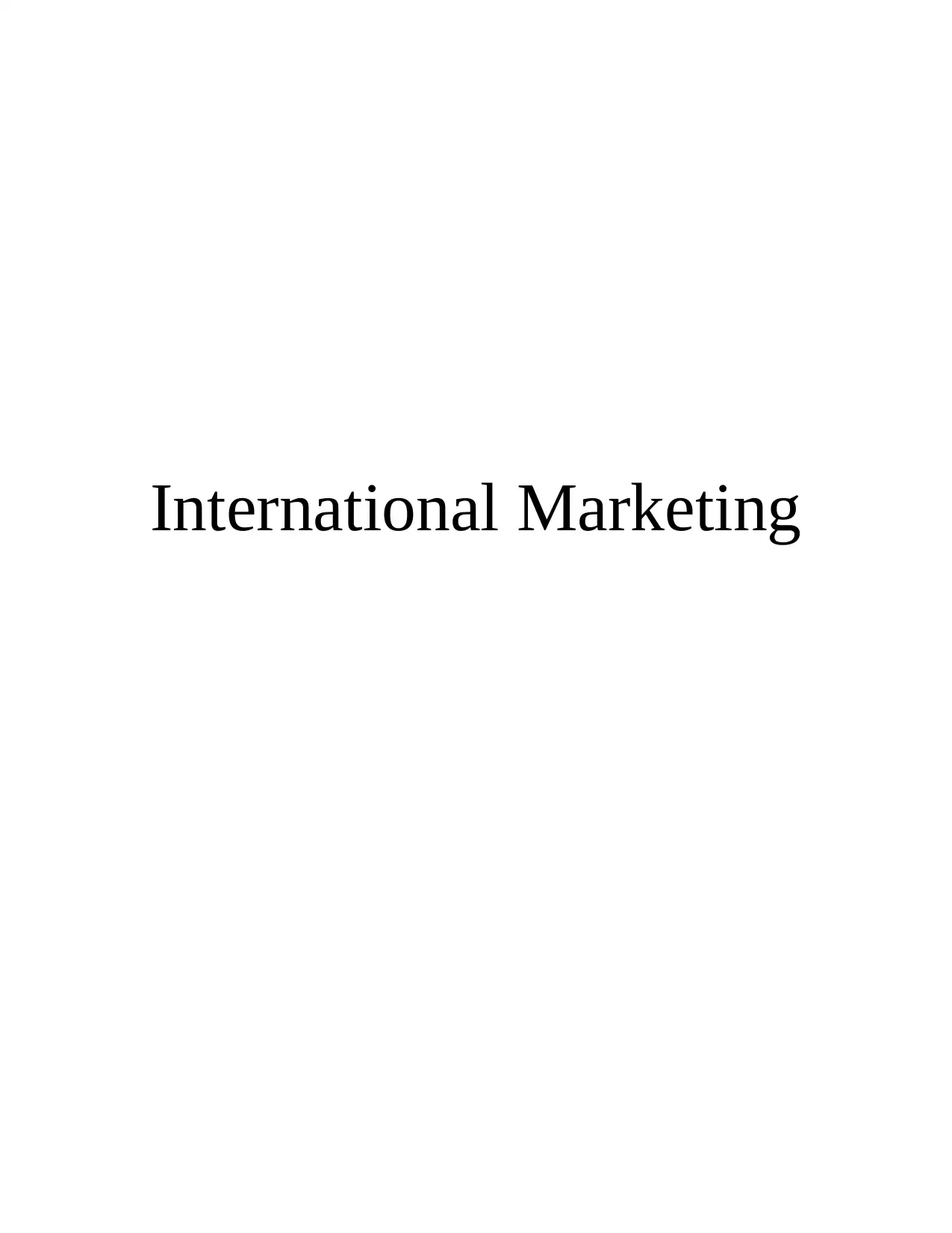
International Marketing
Paraphrase This Document
Need a fresh take? Get an instant paraphrase of this document with our AI Paraphraser
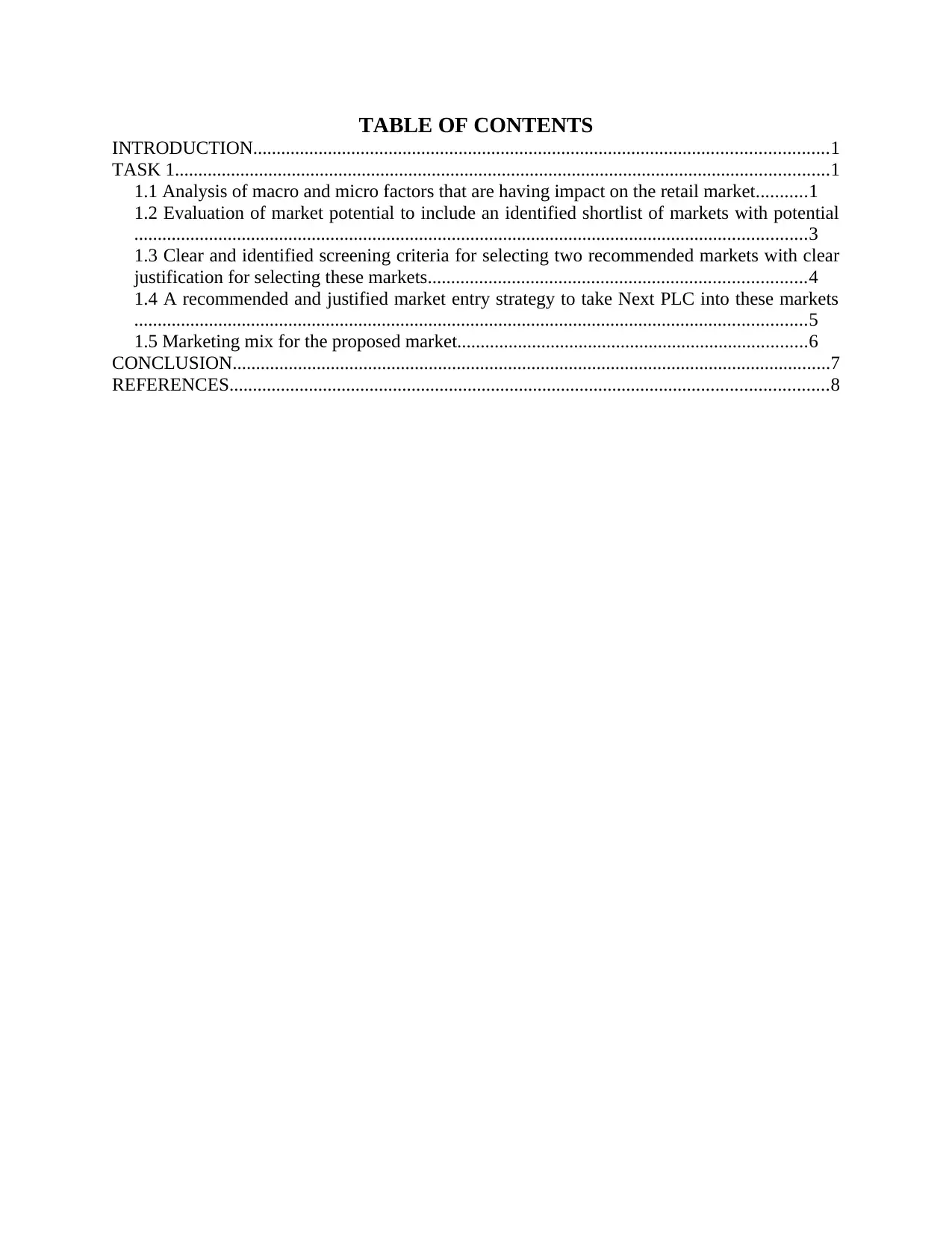
TABLE OF CONTENTS
INTRODUCTION...........................................................................................................................1
TASK 1............................................................................................................................................1
1.1 Analysis of macro and micro factors that are having impact on the retail market...........1
1.2 Evaluation of market potential to include an identified shortlist of markets with potential
................................................................................................................................................3
1.3 Clear and identified screening criteria for selecting two recommended markets with clear
justification for selecting these markets.................................................................................4
1.4 A recommended and justified market entry strategy to take Next PLC into these markets
................................................................................................................................................5
1.5 Marketing mix for the proposed market...........................................................................6
CONCLUSION................................................................................................................................7
REFERENCES................................................................................................................................8
INTRODUCTION...........................................................................................................................1
TASK 1............................................................................................................................................1
1.1 Analysis of macro and micro factors that are having impact on the retail market...........1
1.2 Evaluation of market potential to include an identified shortlist of markets with potential
................................................................................................................................................3
1.3 Clear and identified screening criteria for selecting two recommended markets with clear
justification for selecting these markets.................................................................................4
1.4 A recommended and justified market entry strategy to take Next PLC into these markets
................................................................................................................................................5
1.5 Marketing mix for the proposed market...........................................................................6
CONCLUSION................................................................................................................................7
REFERENCES................................................................................................................................8
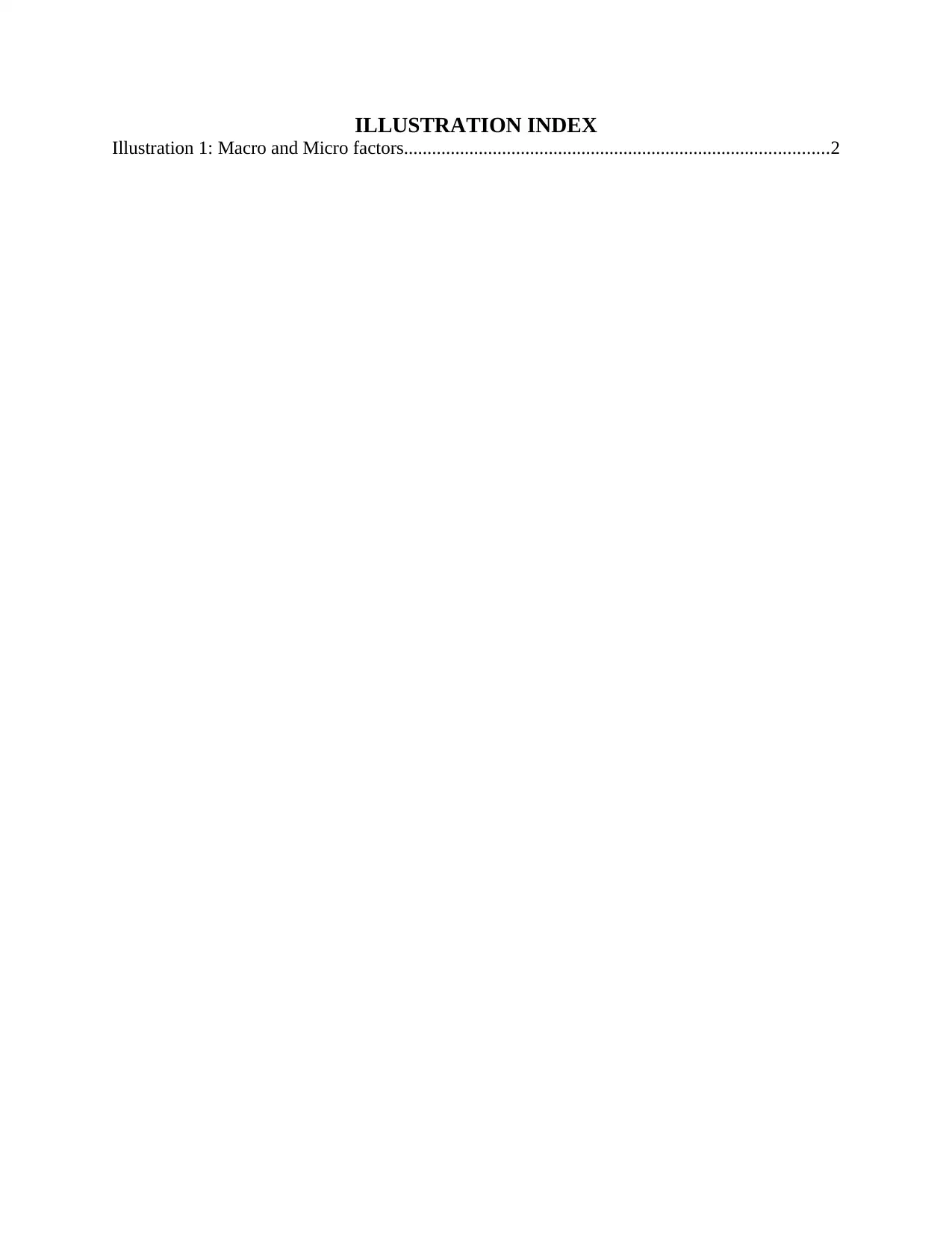
ILLUSTRATION INDEX
Illustration 1: Macro and Micro factors...........................................................................................2
Illustration 1: Macro and Micro factors...........................................................................................2
⊘ This is a preview!⊘
Do you want full access?
Subscribe today to unlock all pages.

Trusted by 1+ million students worldwide
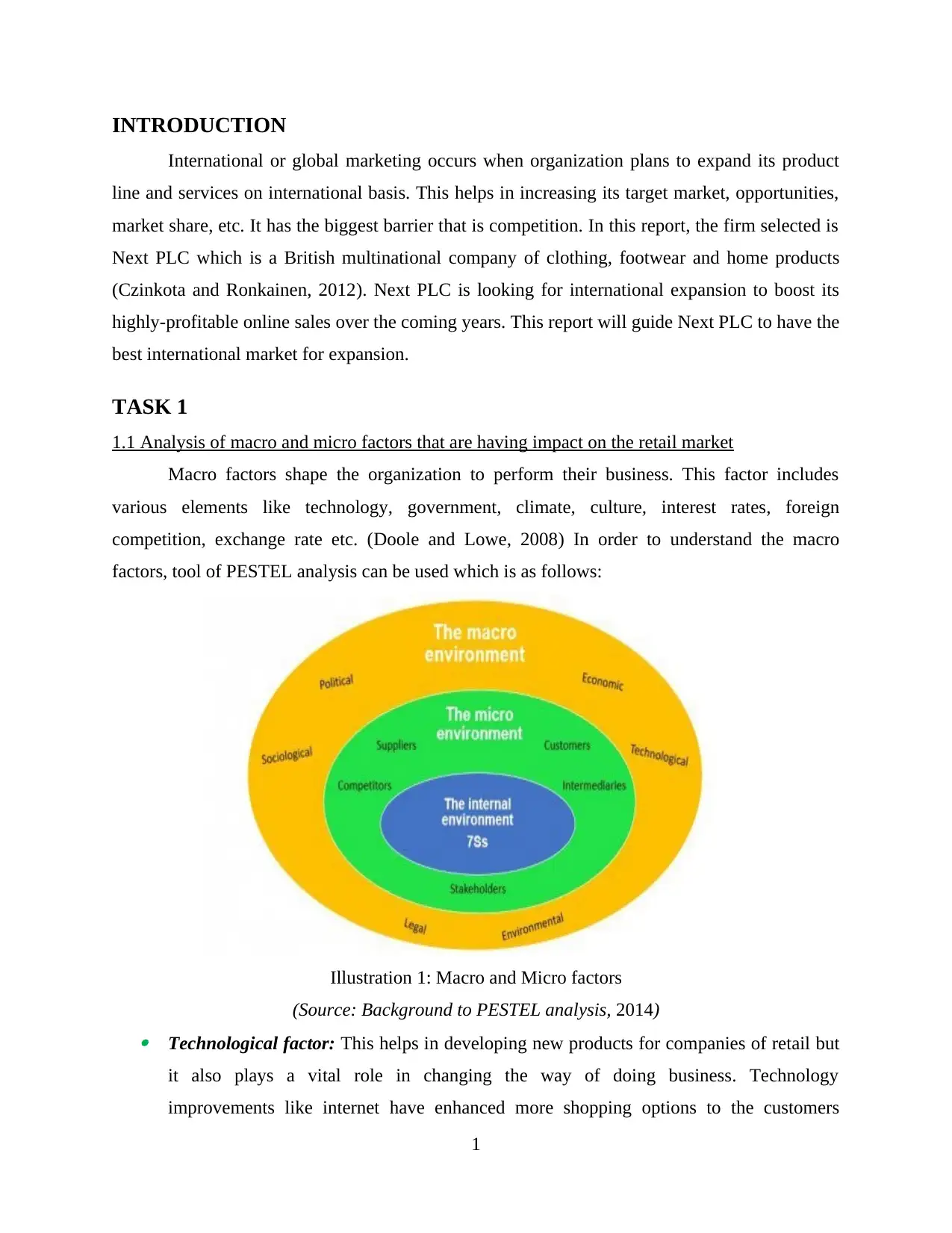
INTRODUCTION
International or global marketing occurs when organization plans to expand its product
line and services on international basis. This helps in increasing its target market, opportunities,
market share, etc. It has the biggest barrier that is competition. In this report, the firm selected is
Next PLC which is a British multinational company of clothing, footwear and home products
(Czinkota and Ronkainen, 2012). Next PLC is looking for international expansion to boost its
highly-profitable online sales over the coming years. This report will guide Next PLC to have the
best international market for expansion.
TASK 1
1.1 Analysis of macro and micro factors that are having impact on the retail market
Macro factors shape the organization to perform their business. This factor includes
various elements like technology, government, climate, culture, interest rates, foreign
competition, exchange rate etc. (Doole and Lowe, 2008) In order to understand the macro
factors, tool of PESTEL analysis can be used which is as follows:
Illustration 1: Macro and Micro factors
(Source: Background to PESTEL analysis, 2014) Technological factor: This helps in developing new products for companies of retail but
it also plays a vital role in changing the way of doing business. Technology
improvements like internet have enhanced more shopping options to the customers
1
International or global marketing occurs when organization plans to expand its product
line and services on international basis. This helps in increasing its target market, opportunities,
market share, etc. It has the biggest barrier that is competition. In this report, the firm selected is
Next PLC which is a British multinational company of clothing, footwear and home products
(Czinkota and Ronkainen, 2012). Next PLC is looking for international expansion to boost its
highly-profitable online sales over the coming years. This report will guide Next PLC to have the
best international market for expansion.
TASK 1
1.1 Analysis of macro and micro factors that are having impact on the retail market
Macro factors shape the organization to perform their business. This factor includes
various elements like technology, government, climate, culture, interest rates, foreign
competition, exchange rate etc. (Doole and Lowe, 2008) In order to understand the macro
factors, tool of PESTEL analysis can be used which is as follows:
Illustration 1: Macro and Micro factors
(Source: Background to PESTEL analysis, 2014) Technological factor: This helps in developing new products for companies of retail but
it also plays a vital role in changing the way of doing business. Technology
improvements like internet have enhanced more shopping options to the customers
1
Paraphrase This Document
Need a fresh take? Get an instant paraphrase of this document with our AI Paraphraser
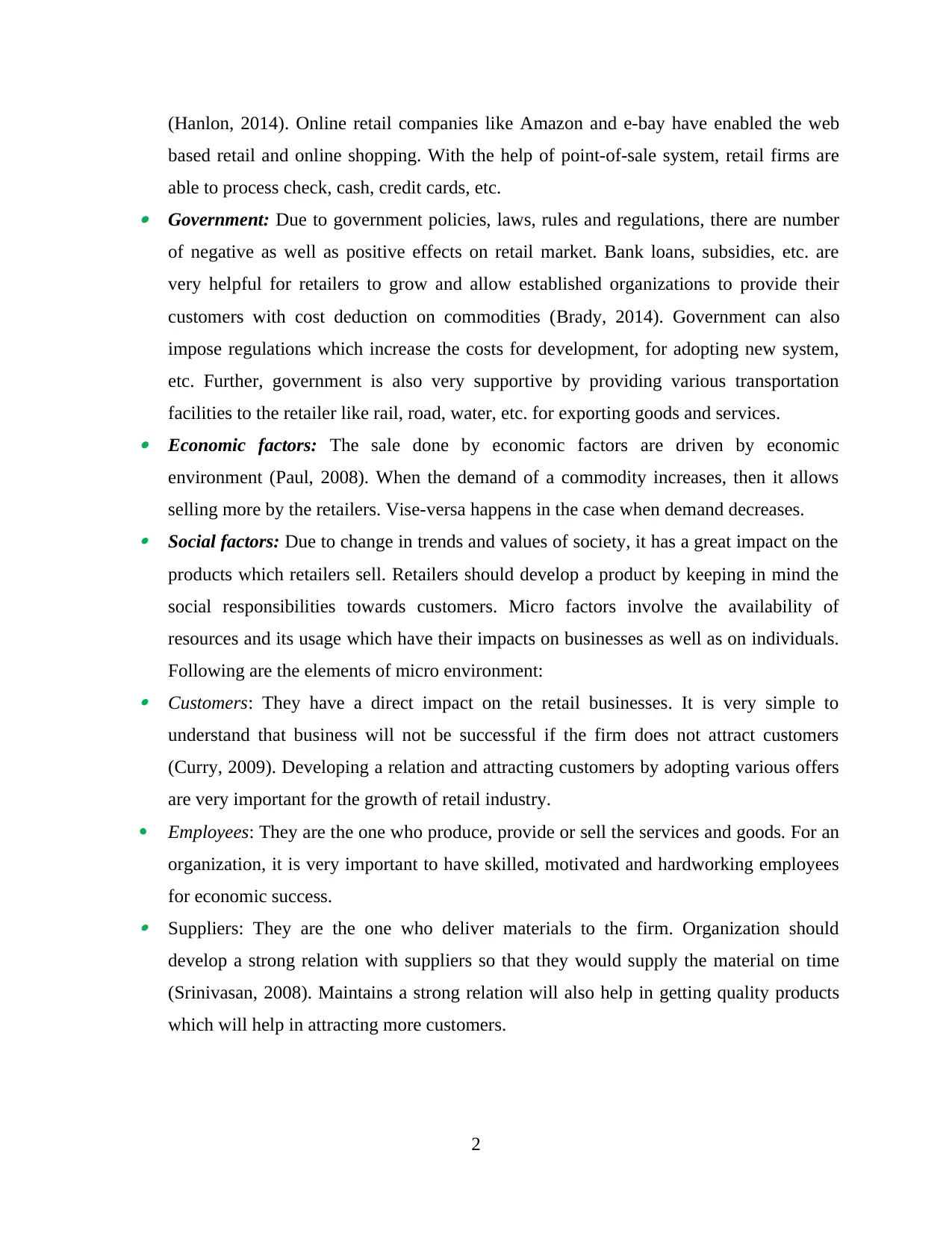
(Hanlon, 2014). Online retail companies like Amazon and e-bay have enabled the web
based retail and online shopping. With the help of point-of-sale system, retail firms are
able to process check, cash, credit cards, etc. Government: Due to government policies, laws, rules and regulations, there are number
of negative as well as positive effects on retail market. Bank loans, subsidies, etc. are
very helpful for retailers to grow and allow established organizations to provide their
customers with cost deduction on commodities (Brady, 2014). Government can also
impose regulations which increase the costs for development, for adopting new system,
etc. Further, government is also very supportive by providing various transportation
facilities to the retailer like rail, road, water, etc. for exporting goods and services. Economic factors: The sale done by economic factors are driven by economic
environment (Paul, 2008). When the demand of a commodity increases, then it allows
selling more by the retailers. Vise-versa happens in the case when demand decreases. Social factors: Due to change in trends and values of society, it has a great impact on the
products which retailers sell. Retailers should develop a product by keeping in mind the
social responsibilities towards customers. Micro factors involve the availability of
resources and its usage which have their impacts on businesses as well as on individuals.
Following are the elements of micro environment: Customers: They have a direct impact on the retail businesses. It is very simple to
understand that business will not be successful if the firm does not attract customers
(Curry, 2009). Developing a relation and attracting customers by adopting various offers
are very important for the growth of retail industry.
Employees: They are the one who produce, provide or sell the services and goods. For an
organization, it is very important to have skilled, motivated and hardworking employees
for economic success. Suppliers: They are the one who deliver materials to the firm. Organization should
develop a strong relation with suppliers so that they would supply the material on time
(Srinivasan, 2008). Maintains a strong relation will also help in getting quality products
which will help in attracting more customers.
2
based retail and online shopping. With the help of point-of-sale system, retail firms are
able to process check, cash, credit cards, etc. Government: Due to government policies, laws, rules and regulations, there are number
of negative as well as positive effects on retail market. Bank loans, subsidies, etc. are
very helpful for retailers to grow and allow established organizations to provide their
customers with cost deduction on commodities (Brady, 2014). Government can also
impose regulations which increase the costs for development, for adopting new system,
etc. Further, government is also very supportive by providing various transportation
facilities to the retailer like rail, road, water, etc. for exporting goods and services. Economic factors: The sale done by economic factors are driven by economic
environment (Paul, 2008). When the demand of a commodity increases, then it allows
selling more by the retailers. Vise-versa happens in the case when demand decreases. Social factors: Due to change in trends and values of society, it has a great impact on the
products which retailers sell. Retailers should develop a product by keeping in mind the
social responsibilities towards customers. Micro factors involve the availability of
resources and its usage which have their impacts on businesses as well as on individuals.
Following are the elements of micro environment: Customers: They have a direct impact on the retail businesses. It is very simple to
understand that business will not be successful if the firm does not attract customers
(Curry, 2009). Developing a relation and attracting customers by adopting various offers
are very important for the growth of retail industry.
Employees: They are the one who produce, provide or sell the services and goods. For an
organization, it is very important to have skilled, motivated and hardworking employees
for economic success. Suppliers: They are the one who deliver materials to the firm. Organization should
develop a strong relation with suppliers so that they would supply the material on time
(Srinivasan, 2008). Maintains a strong relation will also help in getting quality products
which will help in attracting more customers.
2
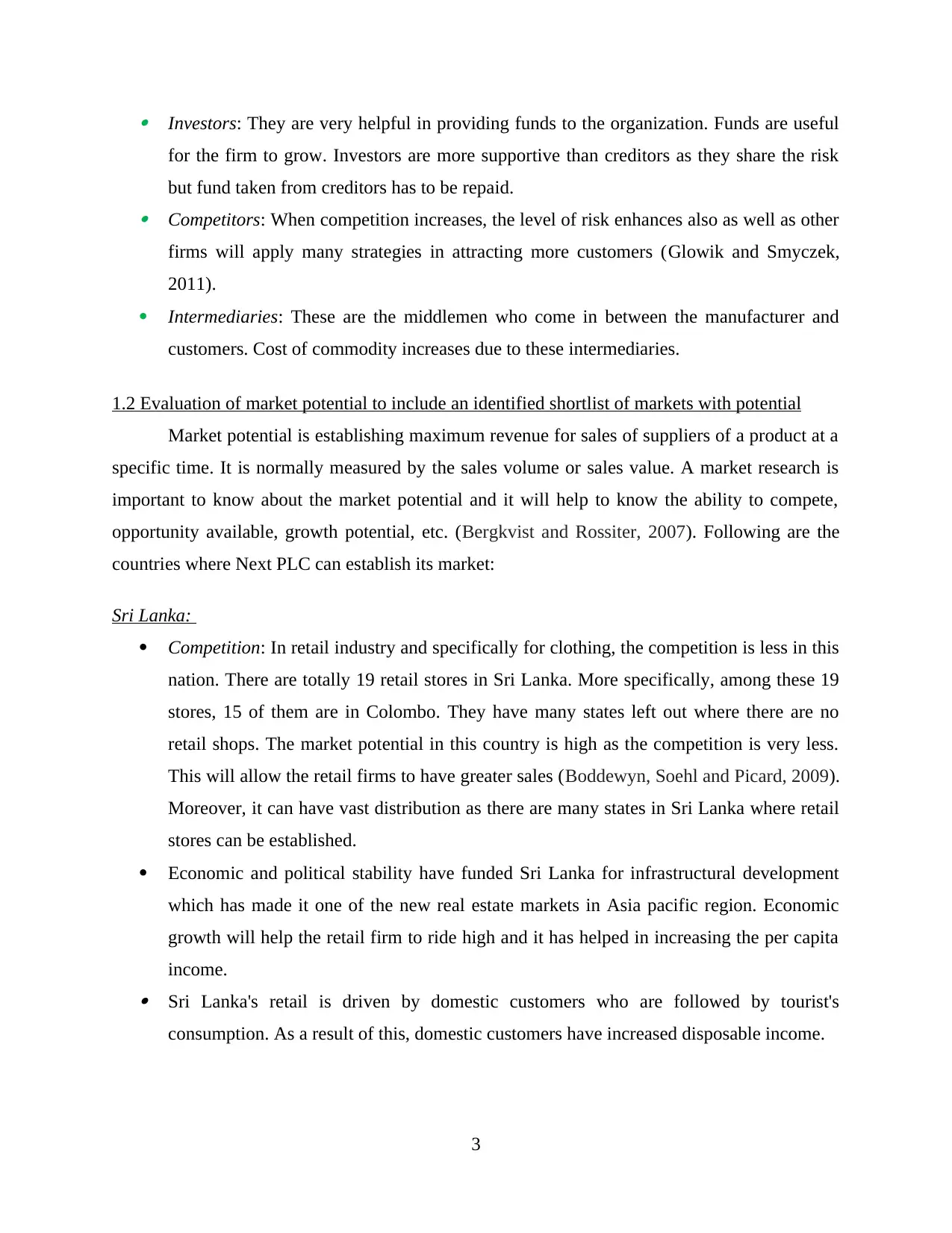
Investors: They are very helpful in providing funds to the organization. Funds are useful
for the firm to grow. Investors are more supportive than creditors as they share the risk
but fund taken from creditors has to be repaid. Competitors: When competition increases, the level of risk enhances also as well as other
firms will apply many strategies in attracting more customers (Glowik and Smyczek,
2011).
Intermediaries: These are the middlemen who come in between the manufacturer and
customers. Cost of commodity increases due to these intermediaries.
1.2 Evaluation of market potential to include an identified shortlist of markets with potential
Market potential is establishing maximum revenue for sales of suppliers of a product at a
specific time. It is normally measured by the sales volume or sales value. A market research is
important to know about the market potential and it will help to know the ability to compete,
opportunity available, growth potential, etc. (Bergkvist and Rossiter, 2007). Following are the
countries where Next PLC can establish its market:
Sri Lanka:
Competition: In retail industry and specifically for clothing, the competition is less in this
nation. There are totally 19 retail stores in Sri Lanka. More specifically, among these 19
stores, 15 of them are in Colombo. They have many states left out where there are no
retail shops. The market potential in this country is high as the competition is very less.
This will allow the retail firms to have greater sales (Boddewyn, Soehl and Picard, 2009).
Moreover, it can have vast distribution as there are many states in Sri Lanka where retail
stores can be established.
Economic and political stability have funded Sri Lanka for infrastructural development
which has made it one of the new real estate markets in Asia pacific region. Economic
growth will help the retail firm to ride high and it has helped in increasing the per capita
income. Sri Lanka's retail is driven by domestic customers who are followed by tourist's
consumption. As a result of this, domestic customers have increased disposable income.
3
for the firm to grow. Investors are more supportive than creditors as they share the risk
but fund taken from creditors has to be repaid. Competitors: When competition increases, the level of risk enhances also as well as other
firms will apply many strategies in attracting more customers (Glowik and Smyczek,
2011).
Intermediaries: These are the middlemen who come in between the manufacturer and
customers. Cost of commodity increases due to these intermediaries.
1.2 Evaluation of market potential to include an identified shortlist of markets with potential
Market potential is establishing maximum revenue for sales of suppliers of a product at a
specific time. It is normally measured by the sales volume or sales value. A market research is
important to know about the market potential and it will help to know the ability to compete,
opportunity available, growth potential, etc. (Bergkvist and Rossiter, 2007). Following are the
countries where Next PLC can establish its market:
Sri Lanka:
Competition: In retail industry and specifically for clothing, the competition is less in this
nation. There are totally 19 retail stores in Sri Lanka. More specifically, among these 19
stores, 15 of them are in Colombo. They have many states left out where there are no
retail shops. The market potential in this country is high as the competition is very less.
This will allow the retail firms to have greater sales (Boddewyn, Soehl and Picard, 2009).
Moreover, it can have vast distribution as there are many states in Sri Lanka where retail
stores can be established.
Economic and political stability have funded Sri Lanka for infrastructural development
which has made it one of the new real estate markets in Asia pacific region. Economic
growth will help the retail firm to ride high and it has helped in increasing the per capita
income. Sri Lanka's retail is driven by domestic customers who are followed by tourist's
consumption. As a result of this, domestic customers have increased disposable income.
3
⊘ This is a preview!⊘
Do you want full access?
Subscribe today to unlock all pages.

Trusted by 1+ million students worldwide
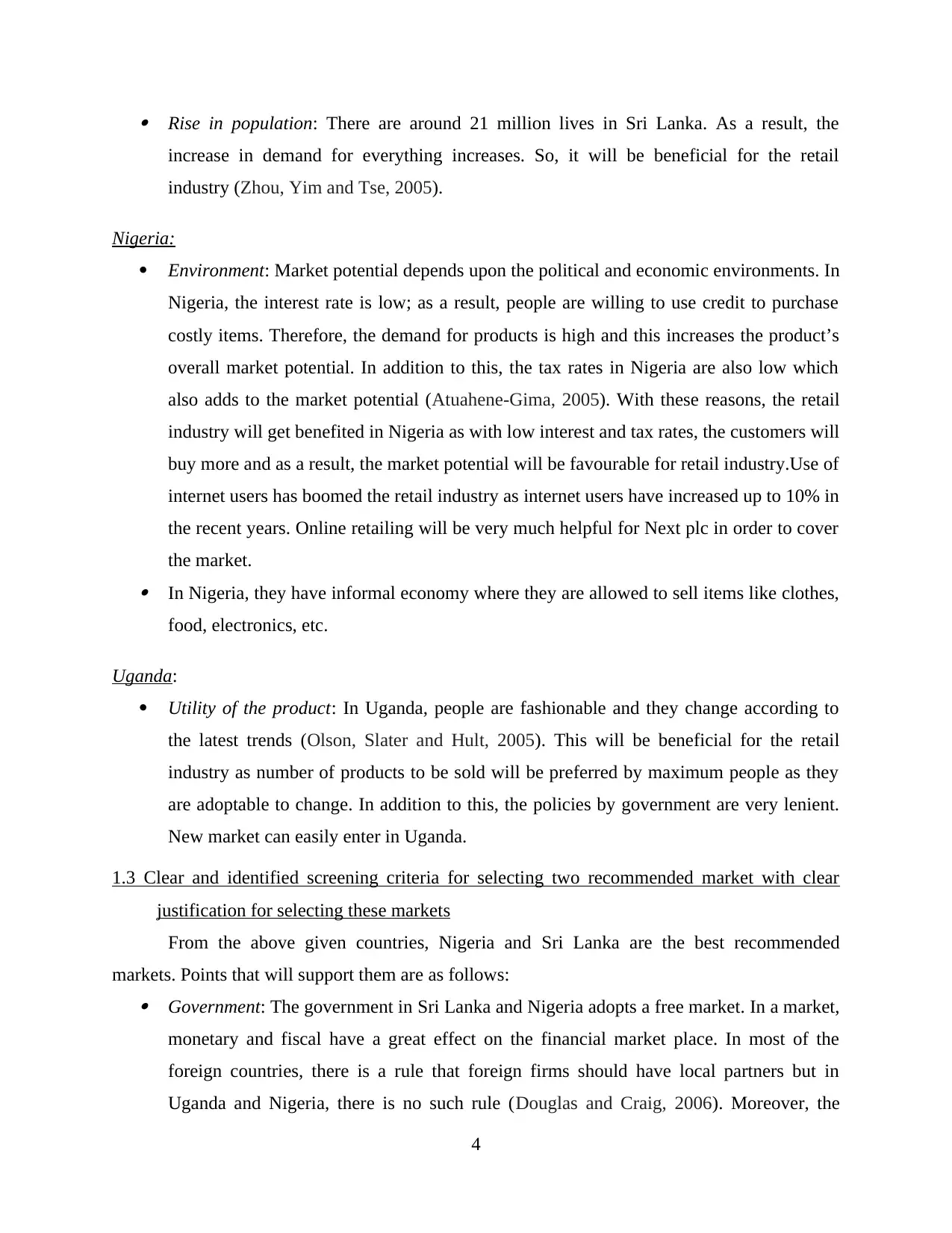
Rise in population: There are around 21 million lives in Sri Lanka. As a result, the
increase in demand for everything increases. So, it will be beneficial for the retail
industry (Zhou, Yim and Tse, 2005).
Nigeria:
Environment: Market potential depends upon the political and economic environments. In
Nigeria, the interest rate is low; as a result, people are willing to use credit to purchase
costly items. Therefore, the demand for products is high and this increases the product’s
overall market potential. In addition to this, the tax rates in Nigeria are also low which
also adds to the market potential (Atuahene-Gima, 2005). With these reasons, the retail
industry will get benefited in Nigeria as with low interest and tax rates, the customers will
buy more and as a result, the market potential will be favourable for retail industry.Use of
internet users has boomed the retail industry as internet users have increased up to 10% in
the recent years. Online retailing will be very much helpful for Next plc in order to cover
the market. In Nigeria, they have informal economy where they are allowed to sell items like clothes,
food, electronics, etc.
Uganda:
Utility of the product: In Uganda, people are fashionable and they change according to
the latest trends (Olson, Slater and Hult, 2005). This will be beneficial for the retail
industry as number of products to be sold will be preferred by maximum people as they
are adoptable to change. In addition to this, the policies by government are very lenient.
New market can easily enter in Uganda.
1.3 Clear and identified screening criteria for selecting two recommended market with clear
justification for selecting these markets
From the above given countries, Nigeria and Sri Lanka are the best recommended
markets. Points that will support them are as follows: Government: The government in Sri Lanka and Nigeria adopts a free market. In a market,
monetary and fiscal have a great effect on the financial market place. In most of the
foreign countries, there is a rule that foreign firms should have local partners but in
Uganda and Nigeria, there is no such rule (Douglas and Craig, 2006). Moreover, the
4
increase in demand for everything increases. So, it will be beneficial for the retail
industry (Zhou, Yim and Tse, 2005).
Nigeria:
Environment: Market potential depends upon the political and economic environments. In
Nigeria, the interest rate is low; as a result, people are willing to use credit to purchase
costly items. Therefore, the demand for products is high and this increases the product’s
overall market potential. In addition to this, the tax rates in Nigeria are also low which
also adds to the market potential (Atuahene-Gima, 2005). With these reasons, the retail
industry will get benefited in Nigeria as with low interest and tax rates, the customers will
buy more and as a result, the market potential will be favourable for retail industry.Use of
internet users has boomed the retail industry as internet users have increased up to 10% in
the recent years. Online retailing will be very much helpful for Next plc in order to cover
the market. In Nigeria, they have informal economy where they are allowed to sell items like clothes,
food, electronics, etc.
Uganda:
Utility of the product: In Uganda, people are fashionable and they change according to
the latest trends (Olson, Slater and Hult, 2005). This will be beneficial for the retail
industry as number of products to be sold will be preferred by maximum people as they
are adoptable to change. In addition to this, the policies by government are very lenient.
New market can easily enter in Uganda.
1.3 Clear and identified screening criteria for selecting two recommended market with clear
justification for selecting these markets
From the above given countries, Nigeria and Sri Lanka are the best recommended
markets. Points that will support them are as follows: Government: The government in Sri Lanka and Nigeria adopts a free market. In a market,
monetary and fiscal have a great effect on the financial market place. In most of the
foreign countries, there is a rule that foreign firms should have local partners but in
Uganda and Nigeria, there is no such rule (Douglas and Craig, 2006). Moreover, the
4
Paraphrase This Document
Need a fresh take? Get an instant paraphrase of this document with our AI Paraphraser
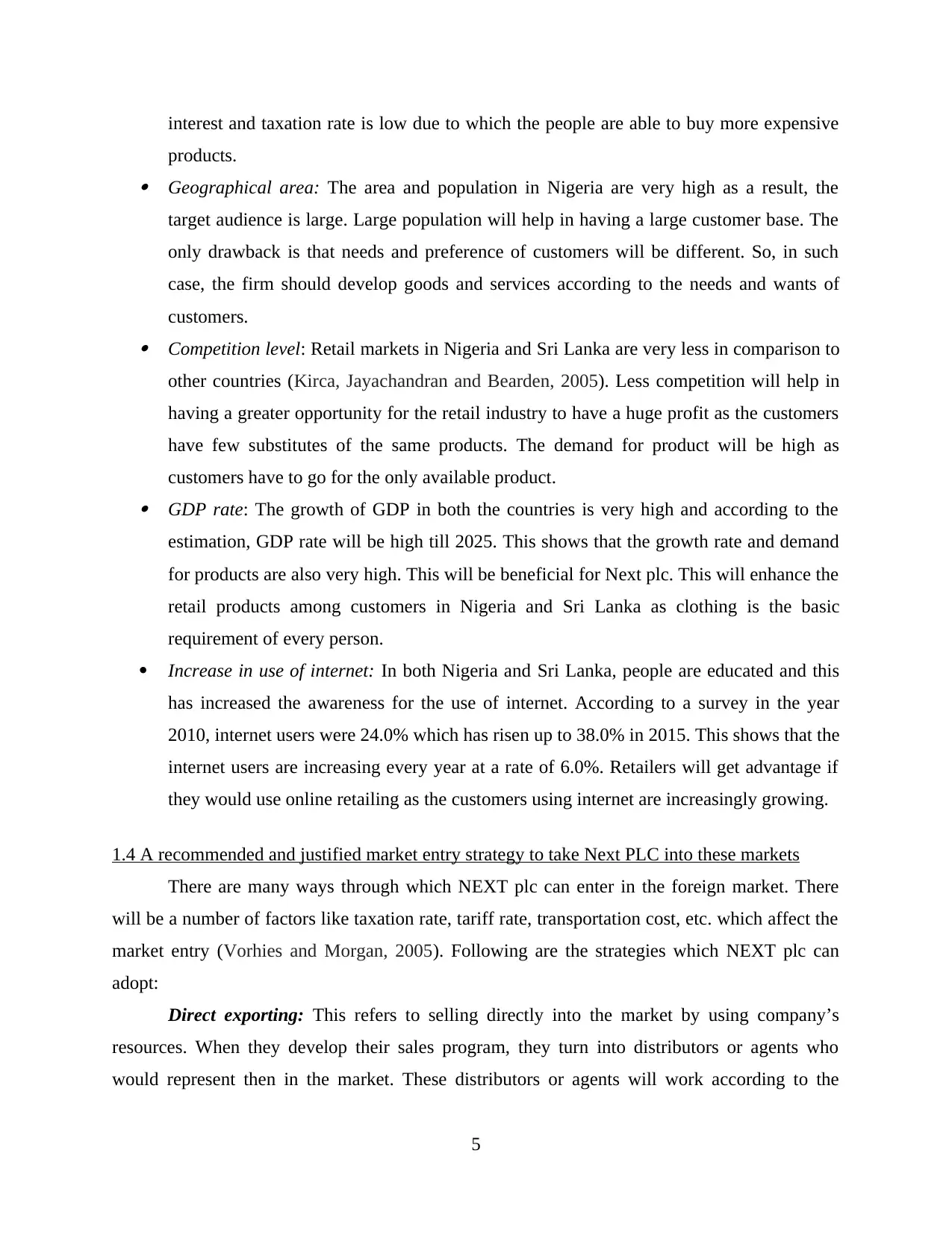
interest and taxation rate is low due to which the people are able to buy more expensive
products. Geographical area: The area and population in Nigeria are very high as a result, the
target audience is large. Large population will help in having a large customer base. The
only drawback is that needs and preference of customers will be different. So, in such
case, the firm should develop goods and services according to the needs and wants of
customers. Competition level: Retail markets in Nigeria and Sri Lanka are very less in comparison to
other countries (Kirca, Jayachandran and Bearden, 2005). Less competition will help in
having a greater opportunity for the retail industry to have a huge profit as the customers
have few substitutes of the same products. The demand for product will be high as
customers have to go for the only available product. GDP rate: The growth of GDP in both the countries is very high and according to the
estimation, GDP rate will be high till 2025. This shows that the growth rate and demand
for products are also very high. This will be beneficial for Next plc. This will enhance the
retail products among customers in Nigeria and Sri Lanka as clothing is the basic
requirement of every person.
Increase in use of internet: In both Nigeria and Sri Lanka, people are educated and this
has increased the awareness for the use of internet. According to a survey in the year
2010, internet users were 24.0% which has risen up to 38.0% in 2015. This shows that the
internet users are increasing every year at a rate of 6.0%. Retailers will get advantage if
they would use online retailing as the customers using internet are increasingly growing.
1.4 A recommended and justified market entry strategy to take Next PLC into these markets
There are many ways through which NEXT plc can enter in the foreign market. There
will be a number of factors like taxation rate, tariff rate, transportation cost, etc. which affect the
market entry (Vorhies and Morgan, 2005). Following are the strategies which NEXT plc can
adopt:
Direct exporting: This refers to selling directly into the market by using company’s
resources. When they develop their sales program, they turn into distributors or agents who
would represent then in the market. These distributors or agents will work according to the
5
products. Geographical area: The area and population in Nigeria are very high as a result, the
target audience is large. Large population will help in having a large customer base. The
only drawback is that needs and preference of customers will be different. So, in such
case, the firm should develop goods and services according to the needs and wants of
customers. Competition level: Retail markets in Nigeria and Sri Lanka are very less in comparison to
other countries (Kirca, Jayachandran and Bearden, 2005). Less competition will help in
having a greater opportunity for the retail industry to have a huge profit as the customers
have few substitutes of the same products. The demand for product will be high as
customers have to go for the only available product. GDP rate: The growth of GDP in both the countries is very high and according to the
estimation, GDP rate will be high till 2025. This shows that the growth rate and demand
for products are also very high. This will be beneficial for Next plc. This will enhance the
retail products among customers in Nigeria and Sri Lanka as clothing is the basic
requirement of every person.
Increase in use of internet: In both Nigeria and Sri Lanka, people are educated and this
has increased the awareness for the use of internet. According to a survey in the year
2010, internet users were 24.0% which has risen up to 38.0% in 2015. This shows that the
internet users are increasing every year at a rate of 6.0%. Retailers will get advantage if
they would use online retailing as the customers using internet are increasingly growing.
1.4 A recommended and justified market entry strategy to take Next PLC into these markets
There are many ways through which NEXT plc can enter in the foreign market. There
will be a number of factors like taxation rate, tariff rate, transportation cost, etc. which affect the
market entry (Vorhies and Morgan, 2005). Following are the strategies which NEXT plc can
adopt:
Direct exporting: This refers to selling directly into the market by using company’s
resources. When they develop their sales program, they turn into distributors or agents who
would represent then in the market. These distributors or agents will work according to the
5
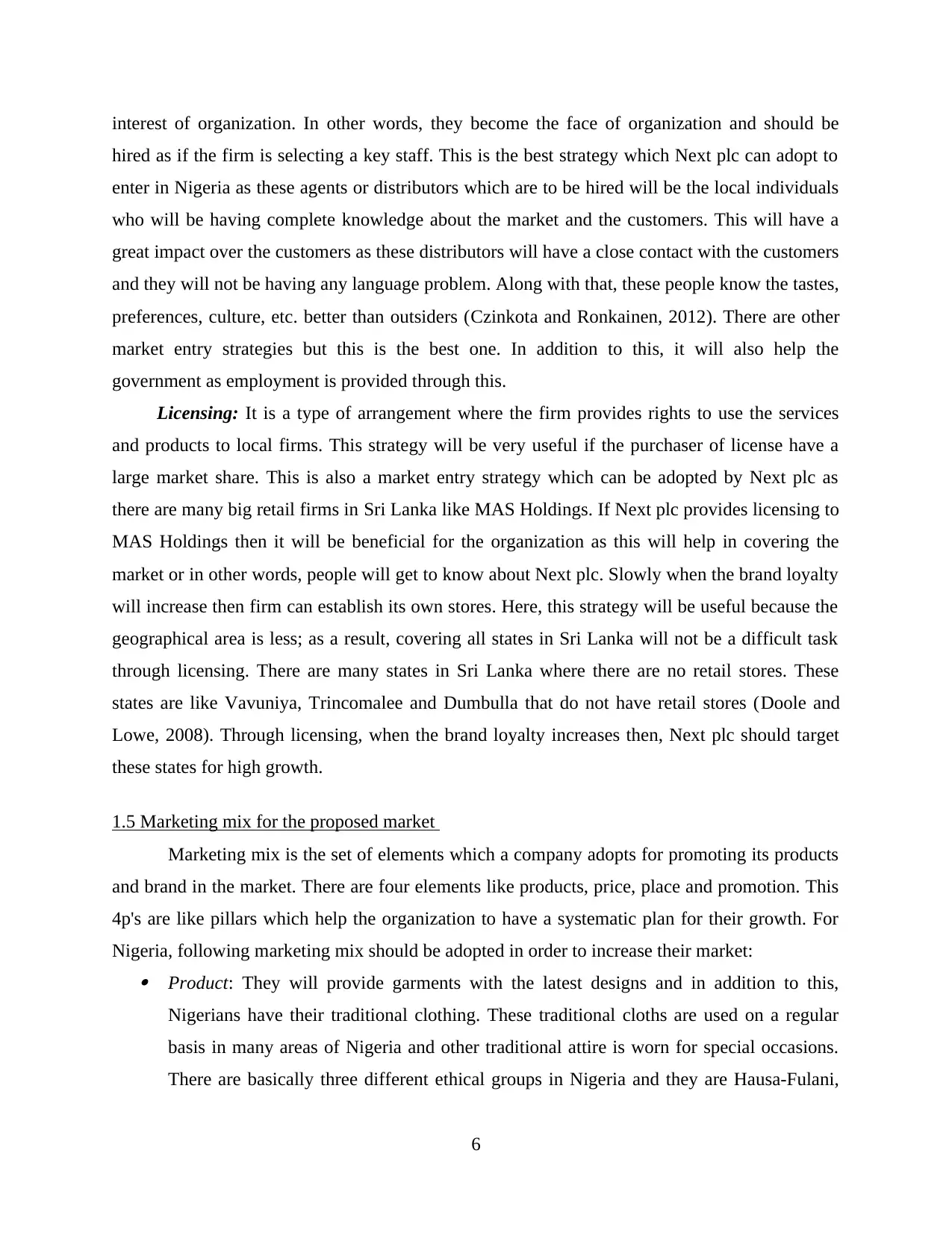
interest of organization. In other words, they become the face of organization and should be
hired as if the firm is selecting a key staff. This is the best strategy which Next plc can adopt to
enter in Nigeria as these agents or distributors which are to be hired will be the local individuals
who will be having complete knowledge about the market and the customers. This will have a
great impact over the customers as these distributors will have a close contact with the customers
and they will not be having any language problem. Along with that, these people know the tastes,
preferences, culture, etc. better than outsiders (Czinkota and Ronkainen, 2012). There are other
market entry strategies but this is the best one. In addition to this, it will also help the
government as employment is provided through this.
Licensing: It is a type of arrangement where the firm provides rights to use the services
and products to local firms. This strategy will be very useful if the purchaser of license have a
large market share. This is also a market entry strategy which can be adopted by Next plc as
there are many big retail firms in Sri Lanka like MAS Holdings. If Next plc provides licensing to
MAS Holdings then it will be beneficial for the organization as this will help in covering the
market or in other words, people will get to know about Next plc. Slowly when the brand loyalty
will increase then firm can establish its own stores. Here, this strategy will be useful because the
geographical area is less; as a result, covering all states in Sri Lanka will not be a difficult task
through licensing. There are many states in Sri Lanka where there are no retail stores. These
states are like Vavuniya, Trincomalee and Dumbulla that do not have retail stores (Doole and
Lowe, 2008). Through licensing, when the brand loyalty increases then, Next plc should target
these states for high growth.
1.5 Marketing mix for the proposed market
Marketing mix is the set of elements which a company adopts for promoting its products
and brand in the market. There are four elements like products, price, place and promotion. This
4p's are like pillars which help the organization to have a systematic plan for their growth. For
Nigeria, following marketing mix should be adopted in order to increase their market: Product: They will provide garments with the latest designs and in addition to this,
Nigerians have their traditional clothing. These traditional cloths are used on a regular
basis in many areas of Nigeria and other traditional attire is worn for special occasions.
There are basically three different ethical groups in Nigeria and they are Hausa-Fulani,
6
hired as if the firm is selecting a key staff. This is the best strategy which Next plc can adopt to
enter in Nigeria as these agents or distributors which are to be hired will be the local individuals
who will be having complete knowledge about the market and the customers. This will have a
great impact over the customers as these distributors will have a close contact with the customers
and they will not be having any language problem. Along with that, these people know the tastes,
preferences, culture, etc. better than outsiders (Czinkota and Ronkainen, 2012). There are other
market entry strategies but this is the best one. In addition to this, it will also help the
government as employment is provided through this.
Licensing: It is a type of arrangement where the firm provides rights to use the services
and products to local firms. This strategy will be very useful if the purchaser of license have a
large market share. This is also a market entry strategy which can be adopted by Next plc as
there are many big retail firms in Sri Lanka like MAS Holdings. If Next plc provides licensing to
MAS Holdings then it will be beneficial for the organization as this will help in covering the
market or in other words, people will get to know about Next plc. Slowly when the brand loyalty
will increase then firm can establish its own stores. Here, this strategy will be useful because the
geographical area is less; as a result, covering all states in Sri Lanka will not be a difficult task
through licensing. There are many states in Sri Lanka where there are no retail stores. These
states are like Vavuniya, Trincomalee and Dumbulla that do not have retail stores (Doole and
Lowe, 2008). Through licensing, when the brand loyalty increases then, Next plc should target
these states for high growth.
1.5 Marketing mix for the proposed market
Marketing mix is the set of elements which a company adopts for promoting its products
and brand in the market. There are four elements like products, price, place and promotion. This
4p's are like pillars which help the organization to have a systematic plan for their growth. For
Nigeria, following marketing mix should be adopted in order to increase their market: Product: They will provide garments with the latest designs and in addition to this,
Nigerians have their traditional clothing. These traditional cloths are used on a regular
basis in many areas of Nigeria and other traditional attire is worn for special occasions.
There are basically three different ethical groups in Nigeria and they are Hausa-Fulani,
6
⊘ This is a preview!⊘
Do you want full access?
Subscribe today to unlock all pages.

Trusted by 1+ million students worldwide
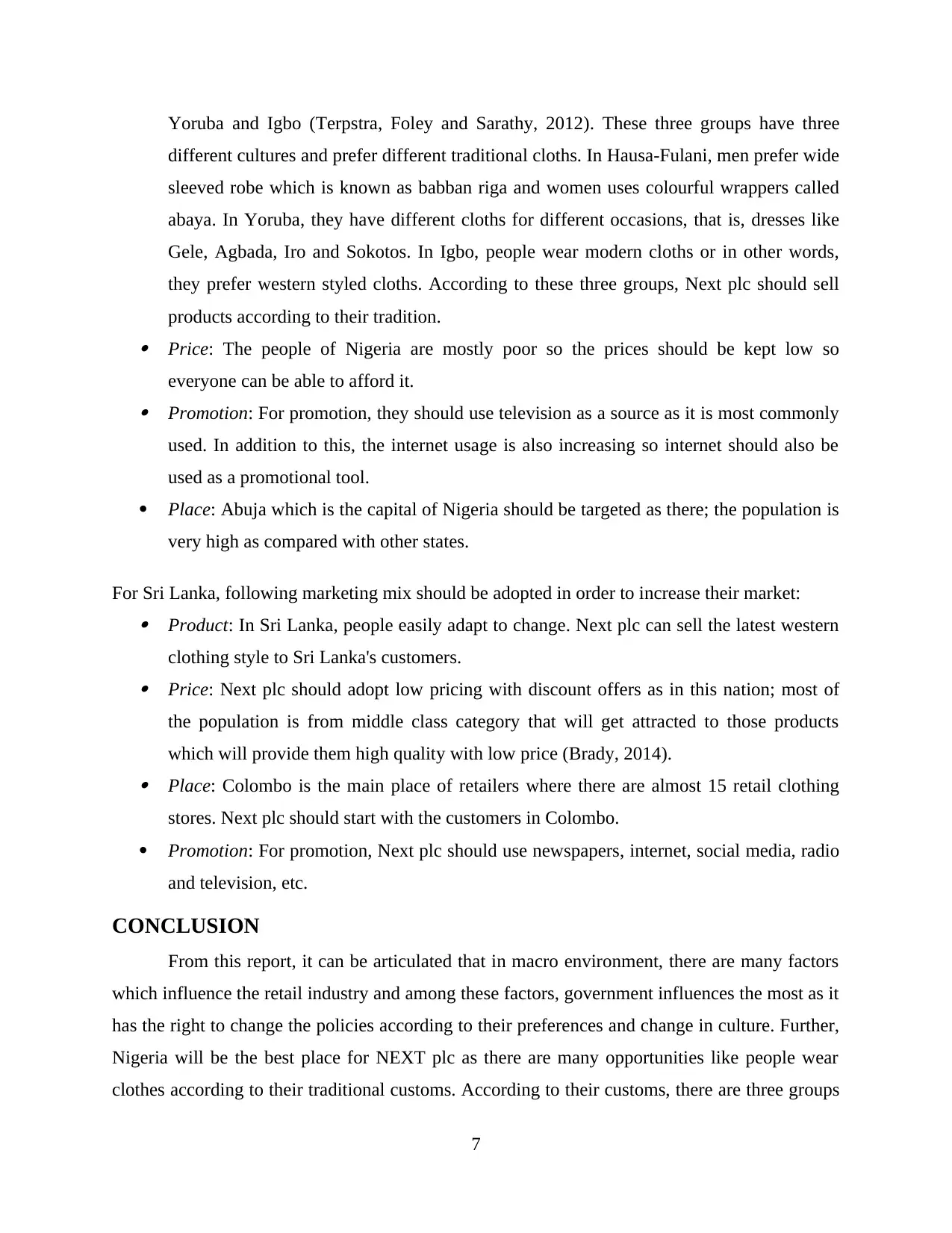
Yoruba and Igbo (Terpstra, Foley and Sarathy, 2012). These three groups have three
different cultures and prefer different traditional cloths. In Hausa-Fulani, men prefer wide
sleeved robe which is known as babban riga and women uses colourful wrappers called
abaya. In Yoruba, they have different cloths for different occasions, that is, dresses like
Gele, Agbada, Iro and Sokotos. In Igbo, people wear modern cloths or in other words,
they prefer western styled cloths. According to these three groups, Next plc should sell
products according to their tradition. Price: The people of Nigeria are mostly poor so the prices should be kept low so
everyone can be able to afford it. Promotion: For promotion, they should use television as a source as it is most commonly
used. In addition to this, the internet usage is also increasing so internet should also be
used as a promotional tool.
Place: Abuja which is the capital of Nigeria should be targeted as there; the population is
very high as compared with other states.
For Sri Lanka, following marketing mix should be adopted in order to increase their market: Product: In Sri Lanka, people easily adapt to change. Next plc can sell the latest western
clothing style to Sri Lanka's customers. Price: Next plc should adopt low pricing with discount offers as in this nation; most of
the population is from middle class category that will get attracted to those products
which will provide them high quality with low price (Brady, 2014). Place: Colombo is the main place of retailers where there are almost 15 retail clothing
stores. Next plc should start with the customers in Colombo.
Promotion: For promotion, Next plc should use newspapers, internet, social media, radio
and television, etc.
CONCLUSION
From this report, it can be articulated that in macro environment, there are many factors
which influence the retail industry and among these factors, government influences the most as it
has the right to change the policies according to their preferences and change in culture. Further,
Nigeria will be the best place for NEXT plc as there are many opportunities like people wear
clothes according to their traditional customs. According to their customs, there are three groups
7
different cultures and prefer different traditional cloths. In Hausa-Fulani, men prefer wide
sleeved robe which is known as babban riga and women uses colourful wrappers called
abaya. In Yoruba, they have different cloths for different occasions, that is, dresses like
Gele, Agbada, Iro and Sokotos. In Igbo, people wear modern cloths or in other words,
they prefer western styled cloths. According to these three groups, Next plc should sell
products according to their tradition. Price: The people of Nigeria are mostly poor so the prices should be kept low so
everyone can be able to afford it. Promotion: For promotion, they should use television as a source as it is most commonly
used. In addition to this, the internet usage is also increasing so internet should also be
used as a promotional tool.
Place: Abuja which is the capital of Nigeria should be targeted as there; the population is
very high as compared with other states.
For Sri Lanka, following marketing mix should be adopted in order to increase their market: Product: In Sri Lanka, people easily adapt to change. Next plc can sell the latest western
clothing style to Sri Lanka's customers. Price: Next plc should adopt low pricing with discount offers as in this nation; most of
the population is from middle class category that will get attracted to those products
which will provide them high quality with low price (Brady, 2014). Place: Colombo is the main place of retailers where there are almost 15 retail clothing
stores. Next plc should start with the customers in Colombo.
Promotion: For promotion, Next plc should use newspapers, internet, social media, radio
and television, etc.
CONCLUSION
From this report, it can be articulated that in macro environment, there are many factors
which influence the retail industry and among these factors, government influences the most as it
has the right to change the policies according to their preferences and change in culture. Further,
Nigeria will be the best place for NEXT plc as there are many opportunities like people wear
clothes according to their traditional customs. According to their customs, there are three groups
7
Paraphrase This Document
Need a fresh take? Get an instant paraphrase of this document with our AI Paraphraser
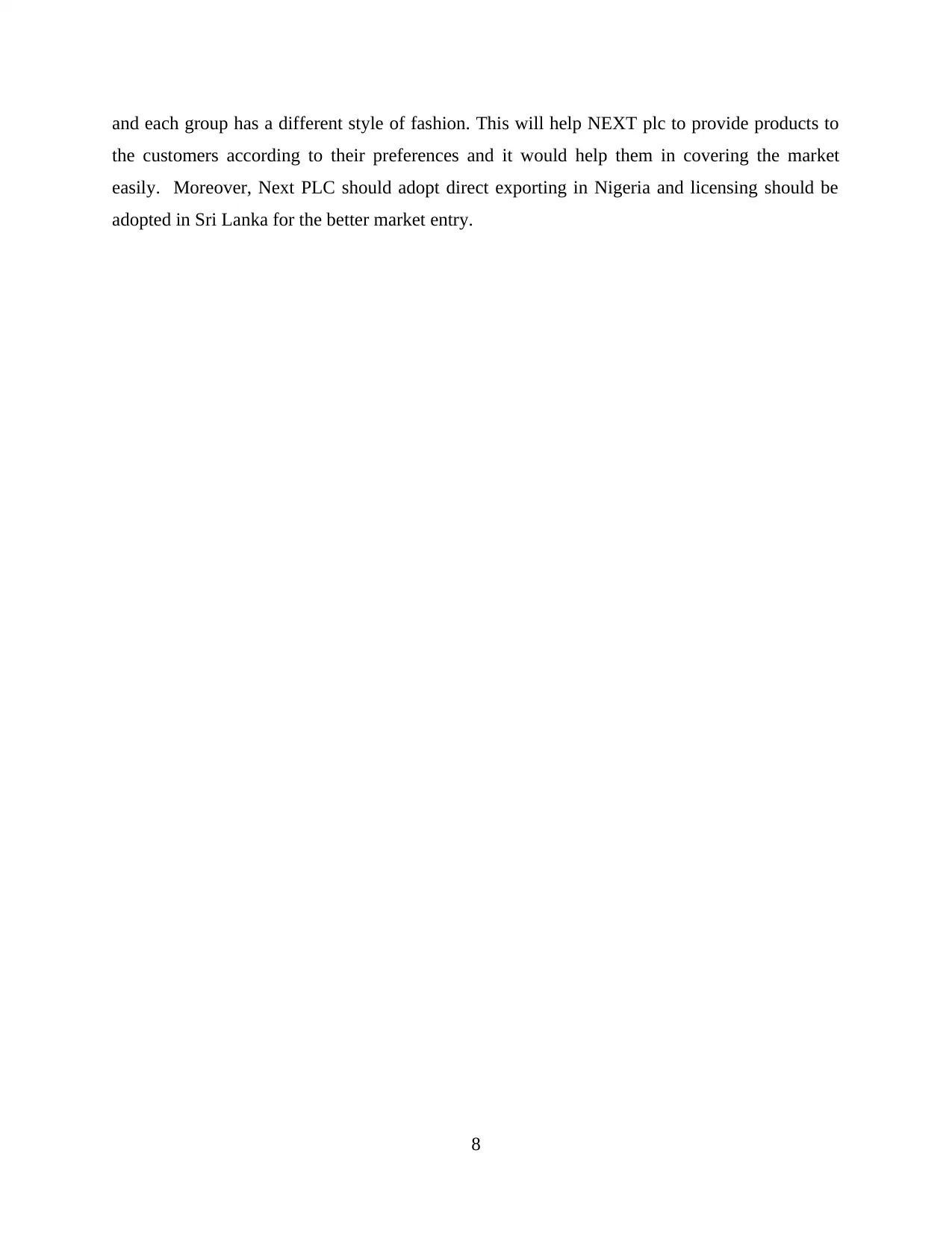
and each group has a different style of fashion. This will help NEXT plc to provide products to
the customers according to their preferences and it would help them in covering the market
easily. Moreover, Next PLC should adopt direct exporting in Nigeria and licensing should be
adopted in Sri Lanka for the better market entry.
8
the customers according to their preferences and it would help them in covering the market
easily. Moreover, Next PLC should adopt direct exporting in Nigeria and licensing should be
adopted in Sri Lanka for the better market entry.
8
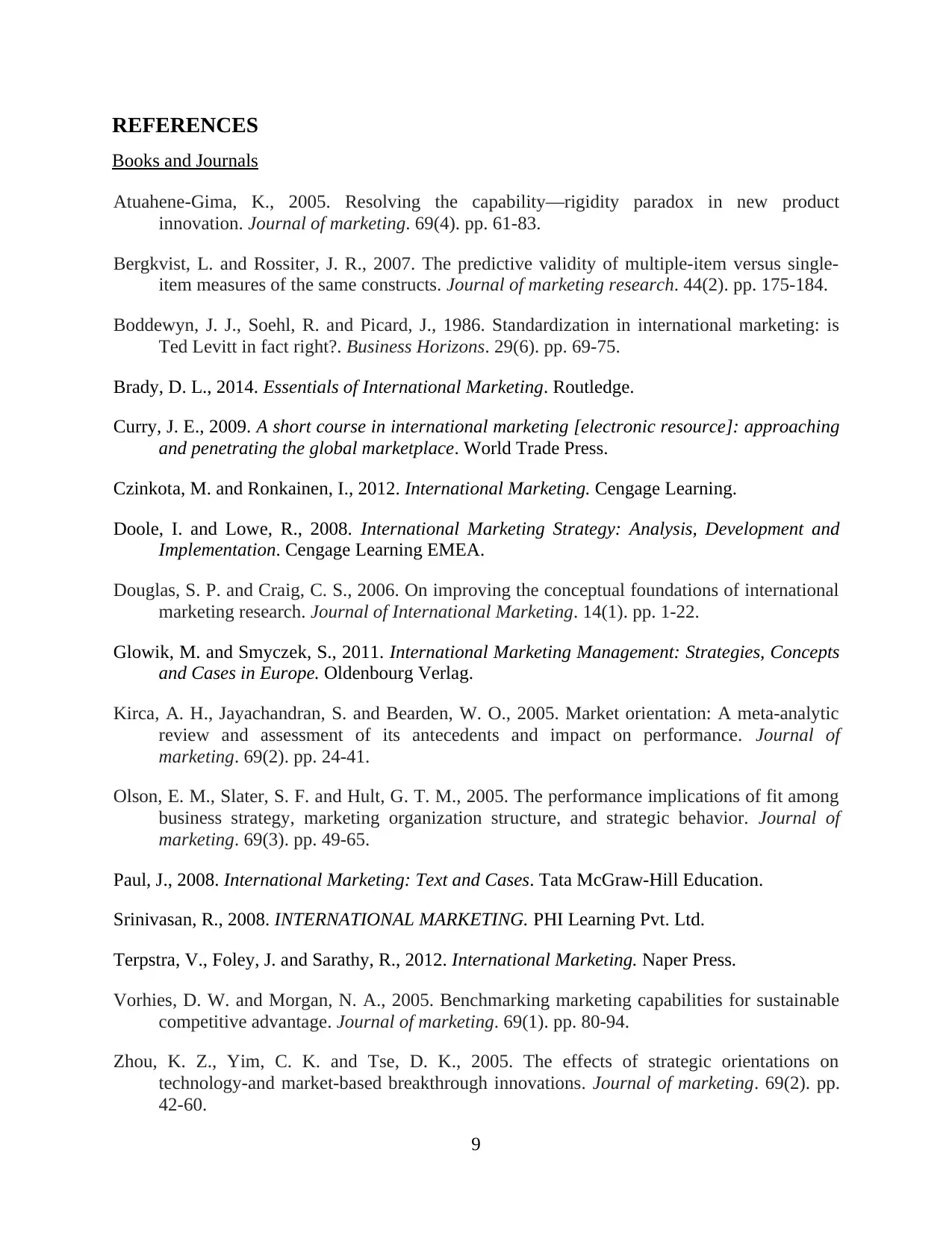
REFERENCES
Books and Journals
Atuahene-Gima, K., 2005. Resolving the capability—rigidity paradox in new product
innovation. Journal of marketing. 69(4). pp. 61-83.
Bergkvist, L. and Rossiter, J. R., 2007. The predictive validity of multiple-item versus single-
item measures of the same constructs. Journal of marketing research. 44(2). pp. 175-184.
Boddewyn, J. J., Soehl, R. and Picard, J., 1986. Standardization in international marketing: is
Ted Levitt in fact right?. Business Horizons. 29(6). pp. 69-75.
Brady, D. L., 2014. Essentials of International Marketing. Routledge.
Curry, J. E., 2009. A short course in international marketing [electronic resource]: approaching
and penetrating the global marketplace. World Trade Press.
Czinkota, M. and Ronkainen, I., 2012. International Marketing. Cengage Learning.
Doole, I. and Lowe, R., 2008. International Marketing Strategy: Analysis, Development and
Implementation. Cengage Learning EMEA.
Douglas, S. P. and Craig, C. S., 2006. On improving the conceptual foundations of international
marketing research. Journal of International Marketing. 14(1). pp. 1-22.
Glowik, M. and Smyczek, S., 2011. International Marketing Management: Strategies, Concepts
and Cases in Europe. Oldenbourg Verlag.
Kirca, A. H., Jayachandran, S. and Bearden, W. O., 2005. Market orientation: A meta-analytic
review and assessment of its antecedents and impact on performance. Journal of
marketing. 69(2). pp. 24-41.
Olson, E. M., Slater, S. F. and Hult, G. T. M., 2005. The performance implications of fit among
business strategy, marketing organization structure, and strategic behavior. Journal of
marketing. 69(3). pp. 49-65.
Paul, J., 2008. International Marketing: Text and Cases. Tata McGraw-Hill Education.
Srinivasan, R., 2008. INTERNATIONAL MARKETING. PHI Learning Pvt. Ltd.
Terpstra, V., Foley, J. and Sarathy, R., 2012. International Marketing. Naper Press.
Vorhies, D. W. and Morgan, N. A., 2005. Benchmarking marketing capabilities for sustainable
competitive advantage. Journal of marketing. 69(1). pp. 80-94.
Zhou, K. Z., Yim, C. K. and Tse, D. K., 2005. The effects of strategic orientations on
technology-and market-based breakthrough innovations. Journal of marketing. 69(2). pp.
42-60.
9
Books and Journals
Atuahene-Gima, K., 2005. Resolving the capability—rigidity paradox in new product
innovation. Journal of marketing. 69(4). pp. 61-83.
Bergkvist, L. and Rossiter, J. R., 2007. The predictive validity of multiple-item versus single-
item measures of the same constructs. Journal of marketing research. 44(2). pp. 175-184.
Boddewyn, J. J., Soehl, R. and Picard, J., 1986. Standardization in international marketing: is
Ted Levitt in fact right?. Business Horizons. 29(6). pp. 69-75.
Brady, D. L., 2014. Essentials of International Marketing. Routledge.
Curry, J. E., 2009. A short course in international marketing [electronic resource]: approaching
and penetrating the global marketplace. World Trade Press.
Czinkota, M. and Ronkainen, I., 2012. International Marketing. Cengage Learning.
Doole, I. and Lowe, R., 2008. International Marketing Strategy: Analysis, Development and
Implementation. Cengage Learning EMEA.
Douglas, S. P. and Craig, C. S., 2006. On improving the conceptual foundations of international
marketing research. Journal of International Marketing. 14(1). pp. 1-22.
Glowik, M. and Smyczek, S., 2011. International Marketing Management: Strategies, Concepts
and Cases in Europe. Oldenbourg Verlag.
Kirca, A. H., Jayachandran, S. and Bearden, W. O., 2005. Market orientation: A meta-analytic
review and assessment of its antecedents and impact on performance. Journal of
marketing. 69(2). pp. 24-41.
Olson, E. M., Slater, S. F. and Hult, G. T. M., 2005. The performance implications of fit among
business strategy, marketing organization structure, and strategic behavior. Journal of
marketing. 69(3). pp. 49-65.
Paul, J., 2008. International Marketing: Text and Cases. Tata McGraw-Hill Education.
Srinivasan, R., 2008. INTERNATIONAL MARKETING. PHI Learning Pvt. Ltd.
Terpstra, V., Foley, J. and Sarathy, R., 2012. International Marketing. Naper Press.
Vorhies, D. W. and Morgan, N. A., 2005. Benchmarking marketing capabilities for sustainable
competitive advantage. Journal of marketing. 69(1). pp. 80-94.
Zhou, K. Z., Yim, C. K. and Tse, D. K., 2005. The effects of strategic orientations on
technology-and market-based breakthrough innovations. Journal of marketing. 69(2). pp.
42-60.
9
⊘ This is a preview!⊘
Do you want full access?
Subscribe today to unlock all pages.

Trusted by 1+ million students worldwide
1 out of 13
Related Documents
Your All-in-One AI-Powered Toolkit for Academic Success.
+13062052269
info@desklib.com
Available 24*7 on WhatsApp / Email
![[object Object]](/_next/static/media/star-bottom.7253800d.svg)
Unlock your academic potential
Copyright © 2020–2025 A2Z Services. All Rights Reserved. Developed and managed by ZUCOL.




